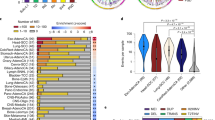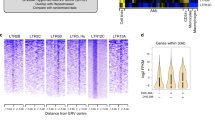Abstract
Retroviral insertional mutagenesis in BXH2 and AKXD mice induces a high incidence of myeloid leukemia and B- and T-cell lymphoma, respectively. The retroviral integration sites (RISs) in these tumors thus provide powerful genetic tags for the discovery of genes involved in cancer1,2. Here we report the first large-scale use of retroviral tagging for cancer gene discovery in the post-genome era. Using high throughput inverse PCR1, we cloned and analyzed the sequences of 884 RISs from a tumor panel composed primarily of B-cell lymphomas. We then compared these sequences, and another 415 RIS sequences previously cloned from BXH2 myeloid leukemias and from a few AKXD lymphomas, against the recently assembled mouse genome sequence. These studies identified 152 loci that are targets of retroviral integration in more than one tumor (common retroviral integration sites, CISs) and therefore likely to encode a cancer gene. Thirty-six CISs encode genes that are known or predicted to be genes involved in human cancer or their homologs, whereas others encode candidate genes that have not yet been examined for a role in human cancer. Our studies demonstrate the power of retroviral tagging for cancer gene discovery in the post-genome era and indicate a largely unrecognized complexity in mouse and presumably human cancer.
This is a preview of subscription content, access via your institution
Access options
Subscribe to this journal
Receive 12 print issues and online access
$209.00 per year
only $17.42 per issue
Buy this article
- Purchase on Springer Link
- Instant access to full article PDF
Prices may be subject to local taxes which are calculated during checkout

Similar content being viewed by others
References
Li, J. et al. Leukaemia disease genes: large-scale cloning and pathway predictions. Nature Genet. 23, 348–353 (1999).
Hansen, G.M., Skapura, D. & Justice, M.J. Genetic profile of insertion mutations in mouse leukemias and lymphomas. Genome Res. 10, 237–243 (2000).
Hartley, J.W. et al. Accelerated appearance of multiple B cell lymphoma types in NFS/N mice congenic for ecotropic murine leukemia viruses. Lab. Invest. 80, 159–169 (2000).
Lazo, P.A., Lee, J.S. & Tsichlis, P.N. Long-distance activation of the Myc protooncogene by provirus insertion in Mlvi-1 or Mlvi-4 in rat T-cell lymphomas. Proc. Natl Acad. Sci. USA 87, 170–173 (1990).
Zeidler, R. et al. Breakpoints of Burkitt's lymphoma t(8;22) translocations map within a distance of 300 kb downstream of MYC. Genes Chromosom. Cancer 9, 282–287 (1994).
Ben-David, Y., Lavigueur, A., Cheong, G.Y. & Bernstein, A. Insertional inactivation of the p53 gene during friend leukemia: a new strategy for identifying tumor suppressor genes. New Biol. 2, 1015–1023 (1990).
Largaespada, D.A., Shaughnessy, J.D. Jr, Jenkins, N.A. & Copeland, N.G. Retroviral integration at the Evi-2 locus in BXH-2 myeloid leukemia cell lines disrupts Nf1 expression without changes in steady-state Ras-GTP levels. J. Virol. 69, 5095–5102 (1995).
Mock, B.A., Liu, L., LePaslier, D. & Huang, S. The B-lymphocyte maturation promoting transcription factor BLIMP1/PRDI-BF1 maps to D6S447 on human chromosome 6q21-q22.1 and the syntenic region of mouse chromosome 10. Genomics 37, 24–28 (1996).
Cao, J. et al. Characterization of colorectal-cancer-related cDNA clones obtained by subtractive hybridization screening. J. Cancer Res. Clin. Oncol. 123, 447–451 (1997).
Neri, A., Fracchiolla, N.S., Migliazza, A., Trecca, D. & Lombardi, L. The involvement of the candidate proto-oncogene NFKB2/lyt-10 in lymphoid malignancies. Leuk. Lymphoma 23, 43–48 (1996).
Tomasetto, C. et al. Identification of four novel human genes amplified and overexpressed in breast carcinoma and localized to the q11-q21.3 region of chromosome 17. Genomics 28, 367–376 (1995).
Collins, C. et al. Positional cloning of ZNF217 and NABC1: genes amplified at 20q13.2 and overexpressed in breast carcinoma. Proc. Natl Acad. Sci. USA 95, 8703–8708 (1998).
Zeng, W.R. et al. Loss of heterozygosity and reduced expression of the CUTL1 gene in uterine leiomyomas. Oncogene 14, 2355–2365 (1997).
Taipale, J. & Beachy, P.A. The Hedgehog and Wnt signalling pathways in cancer. Nature 411, 349–354 (2001).
Nakamura, T., Largaespada, D.A., Shaughnessy, J.D. Jr., Jenkins, N.A. & Copeland, N.G. Cooperative activation of Hoxa and Pbx1-related genes in murine myeloid leukaemias. Nature Genet. 12, 149–153 (1996).
Lund, A.H. et al. Genome-wide retroviral insertional tagging of cancer genes in Cdkn2a-deficient mice. Nature Genet. 32, 80–85 (2002); advance online publication, 19 August 2002 (doi:10.1038/ng956).
Mikkers, H. et al. High-throughput retroviral tagging to identify components of specific signaling pathways in cancer. Nature Genet. 32, 73–79 (2002); advance online publication, 19 August 2002 (doi:10.1038/ng950).
Mitelman, F., Mertens, F. & Johansson, B. A breakpoint map of recurrent chromosomal rearrangements in human neoplasia. Nature Genet. 15 (Spec. No.), 417–474 (1997).
Pollack, J.R. et al. Genome-wide analysis of DNA copy-number changes using cDNA microarrays. Nature Genet. 23, 41–46 (1999).
Luo, G. et al. Cancer predisposition caused by elevated mitotic recombination in Bloom mice. Nature Genet. 26, 424–429 (2000).
Dupuy, A.J., Fritz, S. & Largaespada, D.A. Transposition and gene disruption in the male germline of the mouse. Genesis 30, 82–88 (2001).
Fischer, S.E., Wienholds, E. & Plasterk, R.H. Regulated transposition of a fish transposon in the mouse germ line. Proc. Natl Acad. Sci. USA 98, 6759–6764 (2001).
Horie, K. et al. Efficient chromosomal transposition of a Tc1/mariner-like transposon Sleeping Beauty in mice. Proc. Natl Acad. Sci. USA 98, 9191–9196 (2001).
Jenkins, N.A., Copeland, N.G., Taylor, B.A., Bedigian, H.G. & Lee, B.K. Ecotropic murine leukemia virus DNA content of normal and lymphomatous tissues of BXH-2 recombinant inbred mice. J. Virol. 42, 379–388 (1982).
Gilbert, D.J., Neumann, P.E., Taylor, B.A., Jenkins, N.A. & Copeland, N.G. Susceptibility of AKXD recombinant inbred mouse strains to lymphomas. J. Virol. 67, 2083–2090 (1993).
Morse, H.C. III et al. Combined histologic and molecular features reveal previously unappreciated subsets of lymphoma in AKXD recombinant inbred mice. Leuk. Res. 25, 719–733 (2001).
Copeland, N.G. & Jenkins, N.A. Development and applications of a molecular genetic linkage map of the mouse genome. Trends Genet. 7, 113–118 (1991).
Acknowledgements
We thank D. Gilbert for help with the interspecific backcross mapping, J. Hartley for the NFS.V+ congenic tumors and S. Chattopadhyay for DNA isolation from NFS.V+ tumors. This research was supported by the National Cancer Institute (N.A.J. and N.G.C.), the National Institute of Allergy and Infectious Diseases (H.C.M.), the Japan Society for the Promotion of Science (K.A.) and the National Science Foundation (D.Q.M.).
Author information
Authors and Affiliations
Corresponding author
Ethics declarations
Competing interests
The authors declare no competing financial interests.
Supplementary information
Rights and permissions
About this article
Cite this article
Suzuki, T., Shen, H., Akagi, K. et al. New genes involved in cancer identified by retroviral tagging. Nat Genet 32, 166–174 (2002). https://doi.org/10.1038/ng949
Received:
Accepted:
Published:
Issue Date:
DOI: https://doi.org/10.1038/ng949
This article is cited by
-
The evolution of preclinical models for myelodysplastic neoplasms
Leukemia (2024)
-
Murine leukemia virus (MLV) P50 protein induces cell transformation via transcriptional regulatory function
Retrovirology (2023)
-
Zfp296 knockout enhances chromatin accessibility and induces a unique state of pluripotency in embryonic stem cells
Communications Biology (2023)
-
Retroviral integrations contribute to elevated host cancer rates during germline invasion
Nature Communications (2021)
-
Chromosomal translocation-mediated evasion from miRNA induces strong MEF2D fusion protein expression, causing inhibition of PAX5 transcriptional activity
Oncogene (2019)



